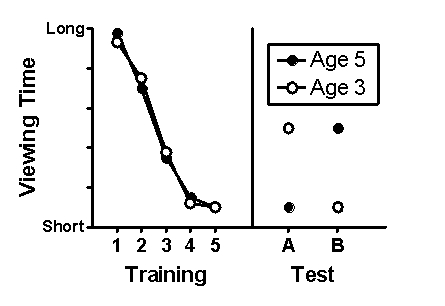Scenario I
Scenario I is based on and presents fabricated results consistent with the following study:
Kim, I. K., & Spelke, E. S. (1992) . Infants' sensitivity to effects of gravity on visual object motion. Journal of Experimental Psychology: Human Perception and Performance, 18(2) , 385-393.
Kim and Spelke (1992) investigated the extent to which infants have expectancies of gravitational effects on visual object motion. Three- and five-month-old infants repeatedly watched a video of a ball accelerating as it rolled down an incline until they spent little time actively looking at it. Subsequently, two types of test trials were conducted in randomized order. Type A test trials consisted of a ball slowing down as it rolled up an incline. Type B test trials consisted of a ball slowing down as it rolled down an incline. During all trials, the amount of time looking at each visual display was recorded. Fabricated data consistent with the major finding of this study are presented in Figure 11.1.
Figure 11.1 
-(Scenario I) Based on the data shown in Figure 11.1, which group(s) of infants, if any, appear to possess a concept of gravity?
A) three-month-olds
B) five-month-olds
C) both groups, although they have different expectancies about gravitational effects
D) neither group
Correct Answer:
Verified
Q1: Scenario II
Scenario II is based on the
Q2: Use the following to answer questions
Scenario
Q3: Scenario II
Scenario II is based on the
Q4: Scenario II
Scenario II is based on the
Q4: Use the following to answer questions
Scenario
Q5: Scenario II
Scenario II is based on the
Q7: Scenario I
Scenario I is based on and
Q8: Scenario I
Scenario I is based on and
Q9: Scenario II
Scenario II is based on the
Q10: Scenario I
Scenario I is based on and
Unlock this Answer For Free Now!
View this answer and more for free by performing one of the following actions

Scan the QR code to install the App and get 2 free unlocks

Unlock quizzes for free by uploading documents